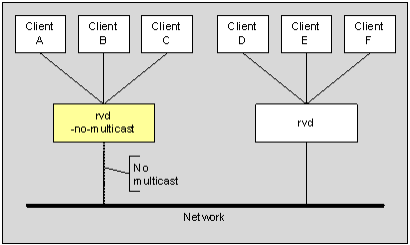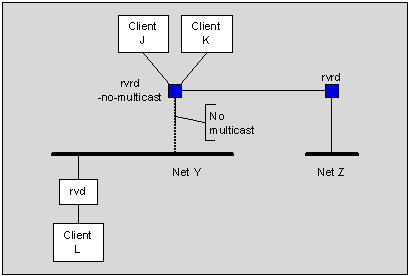Disabling Multicast
When the command line for any daemon includes -no-multicast, the daemon disables all UDP traffic to and from the affected daemon (multicast, broadcast and point-to-point). This section describes the behavior of the daemons (rvd, rvrd, rvsd, rvsrd) when multicasting is disabled.
All changes in behavior occur within the daemon. These behavior changes are transparent to Rendezvous API calls. Client programs can create transports that specify multicast addressing service, send messages to any subjects, and listen to any subjects. No changes to client programs are required.
Disabling multicast communication changes daemon behavior in these ways:
| • | When a client sends a message to a public subject, the daemon does not multicast it (nor broadcast it) to the network. |
| • | When a routing daemon receives multicast or broadcast messages from the network, it does not forward them to other daemons within the local network. |
When multicast communication is disabled, daemons continue to operate in these ways:
| • | All messages (including public subjects) flow among all the clients of the daemon. |
For example, in Disabling Multicast: Public Subjects Still Flow Among Local Clients, even though they connect to a daemon that has disabled multicast, clients A, B and C can still exchange public subjects among themselves. However, they can exchange only point-to-point messages with D, E and F (clients of another daemon).
| • | All messages (including public subjects) flow in both directions between local clients of a routing daemon and the daemon’s neighbors. |
For example, in Disabling Multicast: Routing Daemons, J and K are local clients of a routing daemon that has disabled multicast. Nonetheless, they can exchange public subjects with transports on net Z. In contrast, L (a client of another daemon on the same network cannot exchange public subjects with transports on net Z, nor with J and K on net Y. (All clients on nets Y and Z can exchange point-to-point messages.)
For another example, see rvsrd.
Figure 37: Disabling Multicast: Public Subjects Still Flow Among Local Clients

Figure 38: Disabling Multicast: Routing Daemons
